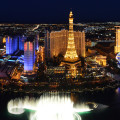
The allure of Las Vegas, with its dazzling lights, world-class entertainment, and endless casinos, has always held a certain mystique. However, recent data reveals a harsh truth lurking beneath the glitz and glamor: Las Vegas is no longer the budget-friendly destination it once was.
The Price of Paradise
A comprehensive study conducted by Forbes Advisor in June 2024 sent shockwaves through the travel industry, exposing the staggering rise in Las Vegas’ travel costs. The city that prides itself on being an accessible playground for all budgets now ranks among the most expensive destinations in the United States.
Over the past five years, Las Vegas has experienced an alarming surge in expenses across multiple categories. Hotel accommodations have skyrocketed by 47%, transforming a once affordable getaway into a luxury endeavor. Renting a car, once a convenient option for exploring the surrounding areas, now comes with a hefty 61% price increase. Even the simple pleasure of dining out has become a costly affair, with daily meal costs surging by 14%.
These figures translate into a sobering reality for travelers. The average nightly rate for a hotel room now stands at $252, while the average cost to rent a car is $77 per day. Dining out for three meals a day can easily set you back $98. These numbers don’t even factor in the cost of airfare, entertainment, gambling, or other activities that are synonymous with the Las Vegas experience.
Behind the Scenes: The Factors Driving the Price Hike
The reasons behind this dramatic price escalation are multifaceted. The city’s rapid post-pandemic economic recovery, coupled with rampant inflation and soaring demand, have all contributed to the escalating costs. Furthermore, the city’s heavy reliance on tourism makes it particularly susceptible to fluctuations in the travel industry.
The COVID-19 pandemic dealt a devastating blow to Las Vegas’s tourism sector, forcing hotels, casinos, and other businesses to close their doors. However, as restrictions eased and pent-up demand surged, the city experienced a remarkable rebound. This resurgence, while positive for the local economy, also fueled a rapid rise in prices as businesses sought to recoup their losses and capitalize on the renewed interest in travel.
The Domino Effect: Impact on Travelers and the Local Economy
The consequences of these rising costs are far-reaching. Budget-conscious travelers, who once flocked to Las Vegas for its affordability, are now forced to reconsider their options. Many are choosing to shorten their stays, cut back on spending, or explore alternative destinations that offer more value for their money.
This shift in traveler behavior is causing concern among industry experts, who fear a potential slowdown in the market. While high-end travelers may continue to indulge in the city’s luxury offerings, the absence of lower-value travelers could have a significant impact on the overall economic health of Las Vegas.
A Glimmer of Hope: The Airfare Advantage
Amidst the gloom, there is a glimmer of hope for potential visitors. The study revealed a surprising 5.5% decrease in the average cost of airfare to and from Las Vegas. This silver lining could potentially offset some of the other increased costs and make the city more accessible for those willing to hunt for deals.
The Road Ahead: Navigating the New Reality
As Las Vegas grapples with its new status as a high-priced destination, the city’s stakeholders face a critical juncture. They must decide whether to cater to the affluent traveler or find ways to attract a wider range of budgets. The path they choose will shape the future of tourism in Las Vegas and determine whether the city can maintain its allure as a global entertainment hub.
In the meantime, travelers considering a trip to Las Vegas must be prepared for a significant financial investment. The days of cheap thrills and bargain deals may be behind us, but the city’s unique blend of entertainment, excitement, and excess continues to beckon those who are willing to pay the price.








